History of electrical engineering
This article details the history of electrical engineering.
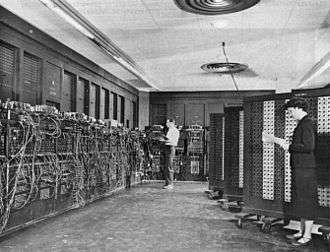
Ancient developments
Long before any knowledge of electricity existed, people were aware of shocks from electric fish. Ancient Egyptian texts dating from 2750 BCE referred to these fish as the "Thunderer of the Nile", and described them as the "protectors" of all other fish. Electric fish were again reported millennia later by ancient Greek, Roman and Arabic naturalists and physicians.[1] Several ancient writers, such as Pliny the Elder and Scribonius Largus, attested to the numbing effect of electric shocks delivered by electric catfish and electric rays, and knew that such shocks could travel along conducting objects.[2] Patients suffering from ailments such as gout or headache were directed to touch electric fish in the hope that the powerful jolt might cure them.[3] Possibly the earliest and nearest approach to the discovery of the identity of lightning, and electricity from any other source, is to be attributed to the Arabs, who before the 15th century had the Arabic word for lightning ra‘ad (رعد) applied to the electric ray.[4]
Ancient cultures around the Mediterranean knew that certain objects, such as rods of amber, could be rubbed with cat's fur to attract light objects like feathers. Thales of Miletus, an ancient Greek philosopher, writing at around 600 BCE, described a form of static electricity, noting that rubbing fur on various substances, such as amber, would cause a particular attraction between the two. He noted that the amber buttons could attract light objects such as hair and that if they rubbed the amber for long enough they could even get a spark to jump.
At around 450 BCE Democritus, a later Greek philosopher, developed an atomic theory that was similar to modern atomic theory. His mentor, Leucippus, is credited with this same theory. The hypothesis of Leucippus and Democritus held everything to be composed of atoms. But these atoms, called "atomos", were indivisible, and indestructible. He presciently stated that between atoms lies empty space, and that atoms are constantly in motion. He was incorrect only in stating that atoms come in different sizes and shapes, and that each object had its own shaped and sized atom.[5][6]
An object found in Iraq in 1938, dated to about 250 BCE and called the Baghdad Battery, resembles a galvanic cell and is claimed by some to have been used for electroplating in Mesopotamia, although there is no evidence for this.
17th-century developments

Electricity would remain little more than an intellectual curiosity for millennia. In 1600, the English scientist, William Gilbert extended the study of Cardano on electricity and magnetism, distinguishing the lodestone effect from static electricity produced by rubbing amber.[7] He coined the New Latin word electricus ("of amber" or "like amber", from ήλεκτρον [elektron], the Greek word for "amber") to refer to the property of attracting small objects after being rubbed.[8] This association gave rise to the English words "electric" and "electricity", which made their first appearance in print in Thomas Browne's Pseudodoxia Epidemica of 1646.[9]
Further work was conducted by Otto von Guericke who showed electrostatic repulsion. Robert Boyle also published work.[10]
18th-century developments
By 1705, Francis Hauksbee had discovered that if he placed a small amount of mercury in the glass of his modified version of Otto von Guericke's generator, evacuated the air from it to create a mild vacuum and rubbed the ball in order to build up a charge, a glow was visible if he placed his hand on the outside of the ball. This glow was bright enough to read by. It seemed to be similar to St. Elmo's Fire. This effect later became the basis of the gas-discharge lamp, which led to neon lighting and mercury vapor lamps. In 1706 he produced an 'Influence machine' to generate this effect.[11] He was elected a Fellow of the Royal Society the same year.[12]
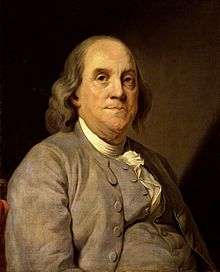
Hauksbee continued to experiment with electricity, making numerous observations and developing machines to generate and demonstrate various electrical phenomena. In 1709 he published Physico-Mechanical Experiments on Various Subjects which summarized much of his scientific work.
Stephen Gray discovered the importance of insulators and conductors. C. F. du Fay seeing his work, developed a "two-fluid" theory of electricity. [10]
In the 18th century, Benjamin Franklin conducted extensive research in electricity, selling his possessions to fund his work. In June 1752 he is reputed to have attached a metal key to the bottom of a dampened kite string and flown the kite in a storm-threatened sky.[13] A succession of sparks jumping from the key to the back of his hand showed that lightning was indeed electrical in nature.[14] He also explained the apparently paradoxical behavior of the Leyden jar as a device for storing large amounts of electrical charge, by coming up with the single fluid, two states theory of electricity.
In 1791, Italian Luigi Galvani published his discovery of bioelectricity, demonstrating that electricity was the medium by which nerve cells passed signals to the muscles.[10][15][16] Alessandro Volta's battery, or voltaic pile, of 1800, made from alternating layers of zinc and copper, provided scientists with a more reliable source of electrical energy than the electrostatic machines previously used.[15][16]
19th-century developments

Electrical engineering became a profession in the late 19th century. Practitioners had created a global electric telegraph network and the first electrical engineering institutions to support the new discipline were founded in the UK and US. Although it is impossible to precisely pinpoint a first electrical engineer, Francis Ronalds stands ahead of the field, who created a working electric telegraph system in 1816 and documented his vision of how the world could be transformed by electricity.[17][18] Over 50 years later, he joined the new Society of Telegraph Engineers (soon to be renamed the Institution of Electrical Engineers) where he was regarded by other members as the first of their cohort.[19] The donation of his extensive electrical library was a considerable boon for the fledgling Society.
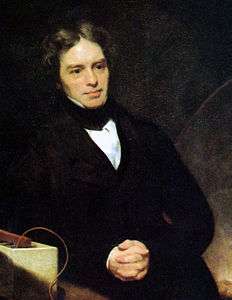
Development of the scientific basis for electrical engineering, with the tools of modern research techniques, intensified during the 19th century. Notable developments early in this century include the work of Georg Ohm, who in 1827 quantified the relationship between the electric current and potential difference in a conductor, Michael Faraday, the discoverer of electromagnetic induction in 1831.[21] In the 1830s, Georg Ohm also constructed an early electrostatic machine. The homopolar generator was developed first by Michael Faraday during his memorable experiments in 1831. It was the beginning of modern dynamos — that is, electrical generators which operate using a magnetic field. The invention of the industrial generator, which didn't need external magnetic power in 1866 by Werner von Siemens made a large series of other inventions in the wake possible.
In 1873 James Clerk Maxwell published a unified treatment of electricity and magnetism in A Treatise on Electricity and Magnetism which stimulated several theorists to think in terms of fields described by Maxwell's equations. In 1878, the British inventor James Wimshurst developed an apparatus that had two glass disks mounted on two shafts. It was not till 1883 that the Wimshurst machine was more fully reported to the scientific community.
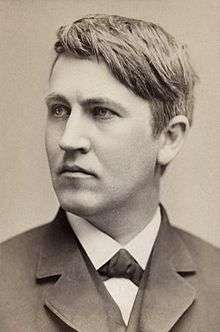
During the latter part of the 1800s, the study of electricity was largely considered to be a subfield of physics. It was not until the late 19th century that universities started to offer degrees in electrical engineering. In 1882, Darmstadt University of Technology founded the first chair and the first faculty of electrical engineering worldwide. In the same year, under Professor Charles Cross, the Massachusetts Institute of Technology began offering the first option of Electrical Engineering within a physics department.[22] In 1883, Darmstadt University of Technology and Cornell University introduced the world's first courses of study in electrical engineering and in 1885 the University College London founded the first chair of electrical engineering in the United Kingdom. The University of Missouri subsequently established the first department of electrical engineering in the United States in 1886.[23]
During this period commercial use of electricity increased dramatically. Starting in the late 1870s cities started installing large scale electric street lighting systems based on arc lamps.[24] After the development of a practical incandescent lamp for indoor lighting, Thomas Edison switched on the world's first public electric supply utility in 1882, using what was considered a relatively safe 110 volts direct current system to supply customers. Engineering advances in the 1880s, including the invention of the transformer, led to electric utilities starting to adopting alternating current, up till then used primarily in arc lighting systems, as a distribution standard for outdoor and indoor lighting (eventually replacing direct current for such purposes). In the US there was a rivalry, primarily between a Westinghouse AC and the Edison DC system known as the "war of the currents".[25]
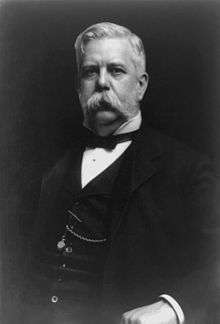
"By the mid-1890s the four "Maxwell equations" were recognized as the foundation of one of the strongest and most successful theories in all of physics; they had taken their place as companions, even rivals, to Newton's laws of mechanics. The equations were by then also being put to practical use, most dramatically in the emerging new technology of radio communications, but also in the telegraph, telephone, and electric power industries."[26] By the end of the 19th century, figures in the progress of electrical engineering were beginning to emerge.[27]
Charles Proteus Steinmetz helped foster the development of alternating current that made possible the expansion of the electric power industry in the United States, formulating mathematical theories for engineers.
Emergence of radio and electronics
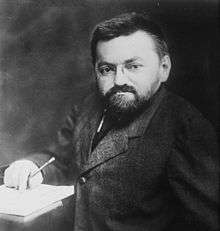
During the development of radio, many scientists and inventors contributed to radio technology and electronics. In his classic UHF experiments of 1888, Heinrich Hertz demonstrated the existence of electromagnetic waves (radio waves) leading many inventors and scientists to try to adapt them to commercial applications, such as Guglielmo Marconi (1895) and Alexander Popov (1896).
Millimetre wave communication was first investigated by Jagadish Chandra Bose during 1894–1896, when he reached an extremely high frequency of up to 60 GHz in his experiments.[28] He also introduced the use of semiconductor junctions to detect radio waves,[29] when he patented the radio crystal detector in 1901.[30][31]
20th-century developments
John Fleming invented the first radio tube, the diode, in 1904.
Reginald Fessenden recognized that a continuous wave needed to be generated to make speech transmission possible, and by the end of 1906 he sent the first radio broadcast of voice. Also in 1906, Robert von Lieben and Lee De Forest independently developed the amplifier tube, called the triode.[32] Edwin Howard Armstrong enabling technology for electronic television, in 1931.[33]
In the early 1920s, there was a growing interest in the development of domestic applications for electricity.[34] Public interest led to exhibitions such featuring "homes of the future" and in the UK, the Electrical Association for Women was established with Caroline Haslett as its director in 1924 to encourage women to become involved in electrical engineering.[35]
World War II years
The second world war saw tremendous advances in the field of electronics; especially in radar and with the invention of the magnetron by Randall and Boot at the University of Birmingham in 1940. Radio location, radio communication and radio guidance of aircraft were all developed at this time. An early electronic computing device, Colossus was built by Tommy Flowers of the GPO to decipher the coded messages of the German Lorenz cipher machine. Also developed at this time were advanced clandestine radio transmitters and receivers for use by secret agents.
An American invention at the time was a device to scramble the telephone calls between Winston Churchill and Franklin D. Roosevelt. This was called the Green Hornet system and worked by inserting noise into the signal. The noise was then extracted at the receiving end. This system was never broken by the Germans.
A great amount of work was undertaken in the United States as part of the War Training Program in the areas of radio direction finding, pulsed linear networks, frequency modulation, vacuum tube circuits, transmission line theory and fundamentals of electromagnetic engineering. These studies were published shortly after the war in what became known as the 'Radio Communication Series' published by McGraw-Hill in 1946.
In 1941 Konrad Zuse presented the Z3, the world's first fully functional and programmable computer.[36]
Post-war years
Prior to the Second World War, the subject was commonly known as 'radio engineering' and was primarily restricted to aspects of communications and radar, commercial radio and early television. At this time, the study of radio engineering at universities could only be undertaken as part of a physics degree.
Later, in post war years, as consumer devices began to be developed, the field broadened to include modern TV, audio systems, Hi-Fi and latterly computers and microprocessors. In 1946 the ENIAC (Electronic Numerical Integrator and Computer) of John Presper Eckert and John Mauchly followed, beginning the computing era. The arithmetic performance of these machines allowed engineers to develop completely new technologies and achieve new objectives, including the Apollo missions and the NASA moon landing.[37]
In the mid-to-late 1950s, the term radio engineering gradually gave way to the name electronics engineering, which then became a stand-alone university degree subject, usually taught alongside electrical engineering with which it had become associated due to some similarities.
Solid-state electronics

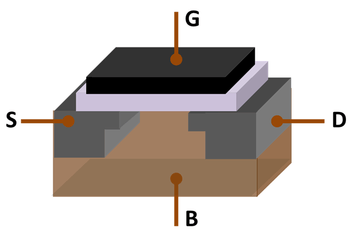
The first working transistor was a point-contact transistor invented by John Bardeen and Walter Houser Brattain while working under William Shockley at the Bell Telephone Laboratories (BTL) in 1947.[38] They then invented the bipolar junction transistor in 1948.[39] While early junction transistors were relatively bulky devices that were difficult to manufacture on a mass-production basis,[40] they opened the door for more compact devices.[41]
The surface passivation process, which electrically stabilized silicon surfaces via thermal oxidation, was developed by Mohamed M. Atalla at BTL in 1957. This led to the development of the monolithic integrated circuit chip.[42][43][44] The first integrated circuits were the hybrid integrated circuit invented by Jack Kilby at Texas Instruments in 1958 and the monolithic integrated circuit chip invented by Robert Noyce at Fairchild Semiconductor in 1959.[45]
The MOSFET (metal-oxide-semiconductor field-effect transistor, or MOS transistor) was invented by Mohamed Atalla and Dawon Kahng at BTL in 1959.[46][47][48] It was the first truly compact transistor that could be miniaturised and mass-produced for a wide range of uses.[40] It revolutionized the electronics industry,[49][50] becoming the most widely used electronic device in the world.[47][51][52] The MOSFET is the basic element in most modern electronic equipment,[53][54] and has been central to the electronics revolution,[55] the microelectronics revolution,[56] and the Digital Revolution.[48][57][58][59] The MOSFET has thus been credited as the birth of modern electronics,[60][61] and possibly the most important invention in electronics.[62]
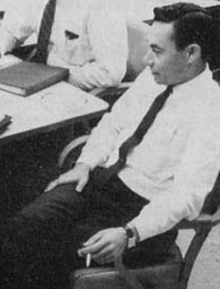
 Robert Noyce – monolithic integrated circuit chip (1959)
Robert Noyce – monolithic integrated circuit chip (1959)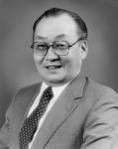 Dawon Kahng – MOSFET transistor (1959)
Dawon Kahng – MOSFET transistor (1959)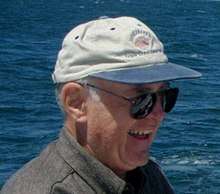
.jpg)
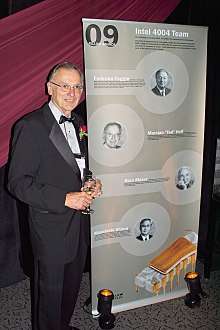 Marcian Hoff – microprocessor (1971)
Marcian Hoff – microprocessor (1971)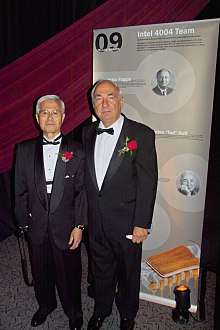
The MOSFET made it possible to build high-density integrated circuit chips.[47] Atalla first proposed the concept of the MOS integrated circuit (MOS IC) chip in 1960, followed by Kahng in 1961.[40][63] The earliest experimental MOS IC chip to be fabricated was built by Fred Heiman and Steven Hofstein at RCA Laboratories in 1962.[64] MOS technology enabled Moore's law, the doubling of transistors on an IC chip every two years, predicted by Gordon Moore in 1965.[65] Silicon-gate MOS technology was developed by Federico Faggin at Fairchild in 1968.[66] Since then, the MOSFET has been the basic building block of modern electronics.[48][67][68] The mass-production of silicon MOSFETs and MOS integrated circuit chips, along with continuous MOSFET scaling miniaturization at an exponential pace (as predicted by Moore's law), has since led to revolutionary changes in technology, economy, culture and thinking.[69]
The Apollo program which culminated in landing astronauts on the Moon with Apollo 11 in 1969 was enabled by NASA's adoption of advances in semiconductor electronic technology, including MOSFETs in the Interplanetary Monitoring Platform (IMP)[70][71] and silicon integrated circuit chips in the Apollo Guidance Computer (AGC).[72]
The development of MOS integrated circuit technology in the 1960s led to the invention of the microprocessor in the early 1970s.[73][54] The first single-chip microprocessor was the Intel 4004, released in 1971.[73] It began with the "Busicom Project"[74] as Masatoshi Shima's three-chip CPU design in 1968,[75][74] before Sharp's Tadashi Sasaki conceived of a single-chip CPU design, which he discussed with Busicom and Intel in 1968.[76] The Intel 4004 was then designed and realized by Federico Faggin at Intel with his silicon-gate MOS technology,[73] along with Intel's Marcian Hoff and Stanley Mazor and Busicom's Masatoshi Shima.[74] This ignited the development of the personal computer. The 4004, a 4-bit processor, was followed in 1973 by the Intel 8080, an 8-bit processor, which made possible the building of the first personal computer, the Altair 8800.[77]
References
- Moller, Peter; Kramer, Bernd (December 1991), "Review: Electric Fish", BioScience, American Institute of Biological Sciences, 41 (11): 794–96 [794], doi:10.2307/1311732, JSTOR 1311732
- Bullock, Theodore H. (2005), Electroreception, Springer, pp. 5–7, ISBN 0-387-23192-7
- Morris, Simon C. (2003), Life's Solution: Inevitable Humans in a Lonely Universe, Cambridge University Press, pp. 182–85, ISBN 0-521-82704-3
- The Encyclopedia Americana; a library of universal knowledge (1918), New York: Encyclopedia Americana Corp
- Russell, Bertrand (1972). A History of Western Philosophy, Simon & Schuster. pp.64-65.
- Barnes, Jonathan.(1987). Early Greek Philosophy, Penguin.
- Stewart, Joseph (2001), Intermediate Electromagnetic Theory, World Scientific, p. 50, ISBN 981-02-4471-1
- Baigrie, Brian (2007), Electricity and Magnetism: A Historical Perspective, Greenwood Press, pp. 7–8, ISBN 978-0-313-33358-3
- Chalmers, Gordon (1937), "The Lodestone and the Understanding of Matter in Seventeenth Century England", Philosophy of Science, 4 (1): 75–95, doi:10.1086/286445
- Guarnieri, M. (2014). "Electricity in the age of Enlightenment". IEEE Industrial Electronics Magazine. 8 (3): 60–63. doi:10.1109/MIE.2014.2335431.CS1 maint: ref=harv (link)
- Burke, James (1978). Connections. London: Macmillan. p. 75. ISBN 0-333-24827-9.
- "Library and Archive Catalogue". Retrieved 2012-03-09.
- Srodes, James (2002), Franklin: The Essential Founding Father, Regnery Publishing, pp. 92–94, ISBN 0-89526-163-4 It is uncertain if Franklin personally carried out this experiment, but it is popularly attributed to him.
- Uman, Martin (1987), All About Lightning (PDF), Dover Publications, ISBN 0-486-25237-X
- Guarnieri, M. (2014). "The Big Jump from the Legs of a Frog". IEEE Industrial Electronics Magazine. 8 (4): 59–61+69. doi:10.1109/MIE.2014.2361237.CS1 maint: ref=harv (link)
- Kirby, Richard S. (1990), Engineering in History, Courier Dover Publications, pp. 331–333, ISBN 0-486-26412-2
- Ronalds, B.F. (2016). Sir Francis Ronalds: Father of the Electric Telegraph. London: Imperial College Press. ISBN 978-1-78326-917-4.
- Ronalds, B.F. (Feb 2016). "The Bicentennial of Francis Ronalds's Electric Telegraph". Physics Today. 69 (2): 26–31. Bibcode:2016PhT....69b..26R. doi:10.1063/PT.3.3079.
- Ronalds, B.F. (July 2016). "Francis Ronalds (1788-1873): The First Electrical Engineer?". Proceedings of the IEEE. doi:10.1109/JPROC.2016.2571358.
- National Portrait gallery NPG 269
- ""Ohm, Georg Simon", "Faraday, Michael"". Encyclopædia Britannica (11 ed.). 1911.
- Weber, Ernst; Frederik Nebeker (1994). The Evolution of Electrical Engineering: A Personal Perspective. IEEE Press. ISBN 0-7803-1066-7.
- Ryder, John; Donald Fink (1984). Engineers and Electrons. IEEE Press. ISBN 0-87942-172-X.
- Quentin R. Skrabec, The 100 Most Significant Events in American Business: An Encyclopedia, ABC-CLIO - 2012, page 86
- Quentin R. Skrabec Jr, The 100 Most Significant Events in American Business - 2012, Page 85
- Bruce J. Hunt (1991) The Maxwellians, page one
- "History". National Fire Protection Association. Archived from the original on September 28, 2007. Retrieved January 19, 2006. (published 1996 in the NFPA Journal)
- "Milestones: First Millimeter-wave Communication Experiments by J.C. Bose, 1894-96". List of IEEE milestones. Institute of Electrical and Electronics Engineers. Retrieved 1 October 2019.
- Emerson, D. T. (1997). "The work of Jagadis Chandra Bose: 100 years of MM-wave research". IEEE Transactions on Microwave Theory and Research. 45 (12): 2267–2273. Bibcode:1997imsd.conf..553E. CiteSeerX 10.1.1.39.8748. doi:10.1109/MWSYM.1997.602853. ISBN 9780986488511. reprinted in Igor Grigorov, Ed., Antentop, Vol. 2, No.3, pp. 87–96.
- "Timeline". The Silicon Engine. Computer History Museum. Retrieved 22 August 2019.
- "1901: Semiconductor Rectifiers Patented as "Cat's Whisker" Detectors". The Silicon Engine. Computer History Museum. Retrieved 23 August 2019.
- "History of Amateur Radio". What is Amateur Radio?. Retrieved January 18, 2006.
- "History of TV". Archived from the original on February 12, 2006. Retrieved January 18, 2006.
- Beauchamp, K. G.; Beauchamp, Kenneth George (1997). Exhibiting Electricity. IET. ISBN 9780852968956.
- "Dame Caroline Haslett". The IET. Retrieved 2018-11-03.
- "The Z3". Archived from the original on February 11, 2006. Retrieved January 18, 2006.
- "The ENIAC Museum Online". Retrieved 2006-01-18.
- "1947: Invention of the Point-Contact Transistor". Computer History Museum. Retrieved 10 August 2019.
- "1948: Conception of the Junction Transistor". The Silicon Engine. Computer History Museum. Retrieved 8 October 2019.
- Moskowitz, Sanford L. (2016). Advanced Materials Innovation: Managing Global Technology in the 21st century. John Wiley & Sons. p. 168. ISBN 9780470508923.
- "Electronics Timeline". Greatest Engineering Achievements of the Twentieth Century. Retrieved 18 January 2006.
- Lojek, Bo (2007). History of Semiconductor Engineering. Springer Science & Business Media. pp. 120& 321–323. ISBN 9783540342588.
- Bassett, Ross Knox (2007). To the Digital Age: Research Labs, Start-up Companies, and the Rise of MOS Technology. Johns Hopkins University Press. p. 46. ISBN 9780801886393.
- Sah, Chih-Tang (October 1988). "Evolution of the MOS transistor-from conception to VLSI" (PDF). Proceedings of the IEEE. 76 (10): 1280–1326 (1290). Bibcode:1988IEEEP..76.1280S. doi:10.1109/5.16328. ISSN 0018-9219.
Those of us active in silicon material and device research during 1956–1960 considered this successful effort by the Bell Labs group led by Atalla to stabilize the silicon surface the most important and significant technology advance, which blazed the trail that led to silicon integrated circuit technology developments in the second phase and volume production in the third phase.
- Saxena, Arjun N. (2009). Invention of Integrated Circuits: Untold Important Facts. World Scientific. p. 140. ISBN 9789812814456.
- "1960 - Metal Oxide Semiconductor (MOS) Transistor Demonstrated". The Silicon Engine. Computer History Museum.
- "Who Invented the Transistor?". Computer History Museum. 4 December 2013. Retrieved 20 July 2019.
- "Triumph of the MOS Transistor". YouTube. Computer History Museum. 6 August 2010. Retrieved 21 July 2019.
- Chan, Yi-Jen (1992). Studies of InAIAs/InGaAs and GaInP/GaAs heterostructure FET's for high speed applications. University of Michigan. p. 1.
The Si MOSFET has revolutionized the electronics industry and as a result impacts our daily lives in almost every conceivable way.
- Grant, Duncan Andrew; Gowar, John (1989). Power MOSFETS: theory and applications. Wiley. p. 1. ISBN 9780471828679.
The metal-oxide-semiconductor field-effect transistor (MOSFET) is the most commonly used active device in the very large-scale integration of digital integrated circuits (VLSI). During the 1970s these components revolutionized electronic signal processing, control systems and computers.
- Golio, Mike; Golio, Janet (2018). RF and Microwave Passive and Active Technologies. CRC Press. pp. 18–2. ISBN 9781420006728.
- "13 Sextillion & Counting: The Long & Winding Road to the Most Frequently Manufactured Human Artifact in History". Computer History Museum. April 2, 2018. Retrieved 28 July 2019.
- Daniels, Lee A. (28 May 1992). "Dr. Dawon Kahng, 61, Inventor In Field of Solid-State Electronics". The New York Times. Retrieved 1 April 2017.
- Colinge, Jean-Pierre; Greer, James C. (2016). Nanowire Transistors: Physics of Devices and Materials in One Dimension. Cambridge University Press. p. 2. ISBN 9781107052406.
- Williams, J. B. (2017). The Electronics Revolution: Inventing the Future. Springer. p. 75. ISBN 9783319490885.
Though these devices were not of great interest at the time, it was to be these Metal Oxide Semiconductor MOS devices that were going to have enormous impact in the future
- Zimbovskaya, Natalya A. (2013). Transport Properties of Molecular Junctions. Springer. p. 231. ISBN 9781461480112.
- Raymer, Michael G. (2009). The Silicon Web: Physics for the Internet Age. CRC Press. p. 365. ISBN 9781439803127.
- Wong, Kit Po (2009). Electrical Engineering - Volume II. EOLSS Publications. p. 7. ISBN 9781905839780.
- "Transistors - an overview". ScienceDirect. Retrieved 8 August 2019.
- Kubozono, Yoshihiro; He, Xuexia; Hamao, Shino; Uesugi, Eri; Shimo, Yuma; Mikami, Takahiro; Goto, Hidenori; Kambe, Takashi (2015). "Application of Organic Semiconductors toward Transistors". Nanodevices for Photonics and Electronics: Advances and Applications. CRC Press. p. 355. ISBN 9789814613750.
- Cerofolini, Gianfranco (2009). Nanoscale Devices: Fabrication, Functionalization, and Accessibility from the Macroscopic World. Springer Science & Business Media. p. 9. ISBN 9783540927327.
- Thompson, S. E.; Chau, R. S.; Ghani, T.; Mistry, K.; Tyagi, S.; Bohr, M. T. (2005). "In search of "Forever," continued transistor scaling one new material at a time". IEEE Transactions on Semiconductor Manufacturing. 18 (1): 26–36. doi:10.1109/TSM.2004.841816. ISSN 0894-6507.
In the field of electronics, the planar Si metal–oxide–semiconductor field-effect transistor (MOSFET) is perhaps the most important invention.
- Bassett, Ross Knox (2007). To the Digital Age: Research Labs, Start-up Companies, and the Rise of MOS Technology. Johns Hopkins University Press. pp. 22–25. ISBN 9780801886393.
- "Tortoise of Transistors Wins the Race - CHM Revolution". Computer History Museum. Retrieved 22 July 2019.
- Franco, Jacopo; Kaczer, Ben; Groeseneken, Guido (2013). Reliability of High Mobility SiGe Channel MOSFETs for Future CMOS Applications. Springer Science & Business Media. pp. 1–2. ISBN 9789400776630.
- "1968: Silicon Gate Technology Developed for ICs". Computer History Museum. Retrieved 22 July 2019.
- McCluskey, Matthew D.; Haller, Eugene E. (2012). Dopants and Defects in Semiconductors. CRC Press. p. 3. ISBN 9781439831533.
- Daniels, Lee A. (28 May 1992). "Dr. Dawon Kahng, 61, Inventor In Field of Solid-State Electronics". The New York Times. Retrieved 1 April 2017.
- Feldman, Leonard C. (2001). "Introduction". Fundamental Aspects of Silicon Oxidation. Springer Science & Business Media. pp. 1–11. ISBN 9783540416821.
- Interplanetary Monitoring Platform (PDF). NASA. 29 August 1989. pp. 1, 11, 134. Retrieved 12 August 2019.
- White, H. D.; Lokerson, D. C. (1971). "The Evolution of IMP Spacecraft Mosfet Data Systems". IEEE Transactions on Nuclear Science. 18 (1): 233–236. doi:10.1109/TNS.1971.4325871. ISSN 0018-9499.
- "Apollo Guidance Computer and the First Silicon Chips". National Air and Space Museum. Smithsonian Institution. 14 October 2015. Retrieved 1 September 2019.
- "1971: Microprocessor Integrates CPU Function onto a Single Chip". Computer History Museum. Retrieved 22 July 2019.
- Federico Faggin, The Making of the First Microprocessor, IEEE Solid-State Circuits Magazine, Winter 2009, IEEE Xplore
- Nigel Tout. "The Busicom 141-PF calculator and the Intel 4004 microprocessor". Retrieved November 15, 2009.
- Aspray, William (1994-05-25). "Oral-History: Tadashi Sasaki". Interview #211 for the Center for the History of Electrical Engineering. The Institute of Electrical and Electronics Engineers, Inc. Retrieved 2013-01-02.
- "Computing History (1971 - 1975)". Retrieved January 18, 2006.
External links
| Wikimedia Commons has media related to History of electrical engineering. |
- Nobel Prize Awards Related to Electrical Engineering (relevant patents included)
- Shock and Awe: The Story of Electricity -- Jim Al-Khalili BBC Horizon
- Electrickery, BBC Radio 4 discussion with Simon Schaffer, Patricia Fara & Iwan Morus (In Our Time, Nov. 4, 2004)